Hit the Beach (Part 9)
Posted by admin on

Today we follow animation’s sun-worshipers into the later 1950’s. Famous Studios really gets bitten by the beach bug, providing three cartoons with beach themes inside a matter of a year and a half, and yet another later on. Warner nearly matches the score, with three films in three years. Tom and Jerry provide a pair. And we even have time for a tropical adventure with a – penguin? Pass the bottle of Coppertone QT, if you please.

 Surf Bored (Paramount/Famous, Little Audrey, 7/17/53 – I. Sparber, dir.) – Not mush of a groundbreaker here. The film follows in the footsteps of some girl-and-dog vs. authority ideas left over from the Little Lulu days (which provided setup for such titles as Man’s Pest Friend (1945)), merely changing the setting to a beachfront, and the authority figure to a lifeguard, determined to make sure that dogs stay off the beach. The not-too-wide-awake guard dozes long enough for Audrey to sneak her dog Pal through under his nose, concealed under her folding beach chair, which appears to pass by under its own power. In one clever gag, Audrey opens a satchel, pulling out her new bathing suit, and begins to peel off her street dress past the shoulder. Pal reacts aghast, and covers his eyes with his long ears, but finally takes a peek to see if the film will retain its G-rating. He is pleased to find that Audrey has climbed inside the satchel, where she is concealed from the neck down as she makes her costume change, then unzips the satchel’s zipper to emerge, strutting in her swimming finery, with all the curves of her plump little arms and legs now on display. Audrey next goes through some routine troubles in struggling to open her beach umbrella, inverting it upside down so that she can climb inside and apply pressure from within. The umbrella merely springs shut, shooting up into the air, then turns righrside up, opening properly in the manner of a parachute upon the descent. She also goes through a short and routine battle with the folding beach chair, lifting the old routines from “Toonerville Picnic” and “Donald’s Vacation”, with Pal finally tugging at just the right place to set the chair up properly, but Audrey’s weight causing it to collapse into another folded mess the moment she sits in it.
Surf Bored (Paramount/Famous, Little Audrey, 7/17/53 – I. Sparber, dir.) – Not mush of a groundbreaker here. The film follows in the footsteps of some girl-and-dog vs. authority ideas left over from the Little Lulu days (which provided setup for such titles as Man’s Pest Friend (1945)), merely changing the setting to a beachfront, and the authority figure to a lifeguard, determined to make sure that dogs stay off the beach. The not-too-wide-awake guard dozes long enough for Audrey to sneak her dog Pal through under his nose, concealed under her folding beach chair, which appears to pass by under its own power. In one clever gag, Audrey opens a satchel, pulling out her new bathing suit, and begins to peel off her street dress past the shoulder. Pal reacts aghast, and covers his eyes with his long ears, but finally takes a peek to see if the film will retain its G-rating. He is pleased to find that Audrey has climbed inside the satchel, where she is concealed from the neck down as she makes her costume change, then unzips the satchel’s zipper to emerge, strutting in her swimming finery, with all the curves of her plump little arms and legs now on display. Audrey next goes through some routine troubles in struggling to open her beach umbrella, inverting it upside down so that she can climb inside and apply pressure from within. The umbrella merely springs shut, shooting up into the air, then turns righrside up, opening properly in the manner of a parachute upon the descent. She also goes through a short and routine battle with the folding beach chair, lifting the old routines from “Toonerville Picnic” and “Donald’s Vacation”, with Pal finally tugging at just the right place to set the chair up properly, but Audrey’s weight causing it to collapse into another folded mess the moment she sits in it.
 Audrey of course can’t leave well enough alone, and starts playing ball with Pal. A toss too high lands in the trash dumpster lid, spinning the rotating lid until it sweeps out from its insides a stream of debris, covering the lifeguard in old banana peels, applecores, etc. Pal is discovered, and forcibly escorted off the beach again. Audrey tries for some disguises, first re-enering the beach wearing a sun hat, under with Pal is conceaed, until the hat gets caught on a prong of a beach umbrella, blowing his cover. Using the same hat, but adding a pair of bathing trunks, Audrey next dresses up Pal as if a kid brother, and walks him on his hind feet past the lifeguard. Unfortunately, leave it to Audrey to think of the dog’s comfort over and above his fashion statement, with the lifeguard catching sight of Pal’s wagging tail protruding through a hole Audrey has provided in the bathing trunks. Audrey and Pal make a run for it into the surf. The lifeguard mistimes his own dive, missing the tide and landing face-first in the sand, with a lobster’s claw clamped to his nose.
Audrey of course can’t leave well enough alone, and starts playing ball with Pal. A toss too high lands in the trash dumpster lid, spinning the rotating lid until it sweeps out from its insides a stream of debris, covering the lifeguard in old banana peels, applecores, etc. Pal is discovered, and forcibly escorted off the beach again. Audrey tries for some disguises, first re-enering the beach wearing a sun hat, under with Pal is conceaed, until the hat gets caught on a prong of a beach umbrella, blowing his cover. Using the same hat, but adding a pair of bathing trunks, Audrey next dresses up Pal as if a kid brother, and walks him on his hind feet past the lifeguard. Unfortunately, leave it to Audrey to think of the dog’s comfort over and above his fashion statement, with the lifeguard catching sight of Pal’s wagging tail protruding through a hole Audrey has provided in the bathing trunks. Audrey and Pal make a run for it into the surf. The lifeguard mistimes his own dive, missing the tide and landing face-first in the sand, with a lobster’s claw clamped to his nose.
 Audrey and Pal hide behind what appears to be a piling in the water. The guard dives in, grabs for Audrey, but instead seizes the piling – which turns out to be an octopus. As the beast seizes the guard with intent of having an early dinner, Audrey and Pal stretch an inflatable inner tune between two pier pilings on shore, and launch Audrey’s beach umbrella with it like a bow from an arrow. The umbrella lands in the octopus’s mouth and opens, expanding the creature helplessly, while the guard safely swims to shore. The final scene shows the word “NO” crossed off the beach’s sign, so that it now reads, “Dogs allowed on this beach.” The guard plays a game of medicine ball with Audrey and Pal, until a kick of the ball from Pal’s hind feet sends the guard crashing backwards into the sign. Though momentarily stunned, he is still not mad when the little pup awakens him with a friendly slurp, and the scene irises out as Audrey laughs and laughs.
Audrey and Pal hide behind what appears to be a piling in the water. The guard dives in, grabs for Audrey, but instead seizes the piling – which turns out to be an octopus. As the beast seizes the guard with intent of having an early dinner, Audrey and Pal stretch an inflatable inner tune between two pier pilings on shore, and launch Audrey’s beach umbrella with it like a bow from an arrow. The umbrella lands in the octopus’s mouth and opens, expanding the creature helplessly, while the guard safely swims to shore. The final scene shows the word “NO” crossed off the beach’s sign, so that it now reads, “Dogs allowed on this beach.” The guard plays a game of medicine ball with Audrey and Pal, until a kick of the ball from Pal’s hind feet sends the guard crashing backwards into the sign. Though momentarily stunned, he is still not mad when the little pup awakens him with a friendly slurp, and the scene irises out as Audrey laughs and laughs.
 Surf and Sound (Paramount/Famous. Herman and Katnip, 3/5/54 – Dave Tendlar, dir.) – Herman and Katnip are next at Famous to try out the sandy shores as a new venue. I’ve skipped one previous tropical outing, “Mice Paradise”, which was covered last year in our “Toons Trip Out” vacation articles. This time, the mice decide to break out of the rut of their hole in Katnip’s wall for a day of leisure at the shore. Several of them have it made in the shade, as two lounge under the “awning” of a cabaña made from an open pint container of ice cream. A boy mouse and his girlfriend recline under separate lenses of a pair of human sunglasses planted handles-first in the sand. Two others enjoy nautical recreation, sailing in a kid’s toy beach pail and paddling with the shovels. Another group takes in the sunshine, while tossing around a beach ball. The festivities abruptly halt, when the beach ball ceases to move in mid-toss – having been caught from above in Katnip’s paws. The mice scurry, but Katnip almost catches one, who escapes by abandoning his bathing suit in the cat’s grip, and racing to the hiding place of his brothers under the pier, picking up a stray matchbox to use as a barrel for covering. With no mouse breakfast, Katnip makes due by devouring the food the mice have brought along in a pucnic basket, unhinging his jaw to down a mammoth sandwich made of all the ingredients at once.
Surf and Sound (Paramount/Famous. Herman and Katnip, 3/5/54 – Dave Tendlar, dir.) – Herman and Katnip are next at Famous to try out the sandy shores as a new venue. I’ve skipped one previous tropical outing, “Mice Paradise”, which was covered last year in our “Toons Trip Out” vacation articles. This time, the mice decide to break out of the rut of their hole in Katnip’s wall for a day of leisure at the shore. Several of them have it made in the shade, as two lounge under the “awning” of a cabaña made from an open pint container of ice cream. A boy mouse and his girlfriend recline under separate lenses of a pair of human sunglasses planted handles-first in the sand. Two others enjoy nautical recreation, sailing in a kid’s toy beach pail and paddling with the shovels. Another group takes in the sunshine, while tossing around a beach ball. The festivities abruptly halt, when the beach ball ceases to move in mid-toss – having been caught from above in Katnip’s paws. The mice scurry, but Katnip almost catches one, who escapes by abandoning his bathing suit in the cat’s grip, and racing to the hiding place of his brothers under the pier, picking up a stray matchbox to use as a barrel for covering. With no mouse breakfast, Katnip makes due by devouring the food the mice have brought along in a pucnic basket, unhinging his jaw to down a mammoth sandwich made of all the ingredients at once.
Enter cousin Herman (in possibly the only installment of the series where Arnold Stang actually sings four lines of the “Skiddle Diddle Dee” theme song). Told by the other mice that Katnip is up to his old tricks, Herman remembers the inherent feline weakness – cats are afraid of water. As Katnip snoozes, Herman takes hold of his tail, and drags the cat closer to the shoreline. The sound of advancing water awakens the cat, who looks up to find himself under the curl of the advancing surf. Borrowing a gag from Heckle and Jeckle’s “Hula Hula Land”, Katnip grabs a stray wooden board, and props up the wave’s crest with it long enough to make a retreat back to shore. Not having looked back to see what has just happened, Herman calls an all clear to the other mice, and tells them to enjoy themselves. But the other mice have seen the true events, and shout a warning to Herman just in tme to avoid Katnip’s pounce. Herman dives into the picnic basket. Katnip hops on top, and reaches a paw into one end of the basket to search for the rodent. On the other side of the basket, Herman inserts Katnip’s tail into the opposite basket flap. Katnip mistakes his tail tip for the mouse, and with a mighty grab, succeeds in yanking himself into the basket. Herman latches both flaps of the basket shit, turns the basket sideways so he can grab the handle, and starts towing the basket back to the sea. But the wicker is not durable, and Katnip escapes through the bottom, then repositions himself with mouth open, right in Herman’s path. Katnip’s jaws snap shut on the mouse, taking in part of the basket handle also. Herman adapts the wicker handle as a weapon, jabbing its jagged broken end into Katnip’s tongue, then propping Katnip’s jaws open with the wicker as Katnip screams, permitting a getaway. Herman dives under one of a series of toy beach pails, and plays a shell game variation similar to Heckle and Jeckle, tunnelling through the sand from one pail to the next – until the cat gets wise, and uses a shovel to take out the sand below a pail before Herman can dig through it. But Herman merely bends back the shovel head, and clobbers Katnip in the face with it.
Enough battling with Katnip in his own element on shore. Let’s get back to Herman’s water advantage. Herman dives into the sea, Katnip having to slam on the brakes in mid-air as he realizes he can’t follow. But don’t count out a resourceful cat, as he reappears with a tall pair of stilts, allowing him the enter the ocean and stay a few inches higher than the waterline. He grabs for the floating mouse, but Herman dives. Defying physics like the crow in ”Aloha Hooey”, Herman lights a match underwater, and sets fire to the wooden stilts. Katnip is thrown into the ocean water, and flails about helplessly, claiming he can’t swim. Merciful Herman tosses hi, a life preserver with a rope attached. Well, actually, Herman has no mercy, as he drops a boulder into the sea, tied to the other end of the rope, which takes the cat down with it. But not for long, as the next wave washes him back ashore, just in time to grab the celebrating mice, except for Herman. Katnip returns to thoughts of his mouse breakfast, threading a skewer through the mice’s bathing trunks, and placing them on a spit over an open fire. Herman has one final trick, and ties a fishing line with baited hook to Katnip’s tail, and the hook out to sea. A large fish takes the bait, then runs with it. The cat is dragged alonh for the ride, and calls in vain for help as he is towed off into the open sea. The mice resume their day of pleasure, with one false alarm, as the beach ball again stops dead in mid air – only this time, it is Herman, standing on the limb of a dead tree, who has caught the ball, and laughs with his cousins at the joke for the iris out.
 Rail Rodents (Paramount/Famous, Herman and Katnip, 11/26/54 – Dave Tendlar, dir.), receives only honorable mention for its ending. The mice adapt their “Skiddle Diddle Dee” theme song, to change the lyrics of the second line to “So long, North. We’re on our way”, riding in a boxcar bound for sunny Florida Conveniently, Katnip is also riding the rods as a hobo underneath the box car. Hearing the music, he investigates, but Herman traps his neck in the box car door, leaving Katnip to helplessly keep his body up with his head by running at top speed along the track bed. Our next sequence appears to have Herman already at their destination, performing a hula with miniature ukelele along a sandy beach. The camera pulls back, revealing he’s only performing before a picture post card in the mail car. Chases abound, with Katnip hung out on the mail bag hook, then dealing with a magician’s trunk in the baggage car and also escaping a tough bull dog, being frozen in a refrigerator car and then sliced into ice cubes by a lawn mower, “walking the plank” off a board of a lumber car into the face of an oncoming engine on the next track, swallowing a whole tank of water from a water tower and then spitting it out to fill an entire box car, and finally blasted by a military artillery gun aboard another car, off to the North Pole, to freeze atop a frozen splash of water made upon his impact. The final scene shows the mice arrived at a posh Miami beach resort, where from a cabaña made of a salt water taffy box, Herman continues to practice his ukelele playing, while supervising the other mice as they bask in old Sol’s rays, turning the mice over periodically with a spatula for an even suntan.
Rail Rodents (Paramount/Famous, Herman and Katnip, 11/26/54 – Dave Tendlar, dir.), receives only honorable mention for its ending. The mice adapt their “Skiddle Diddle Dee” theme song, to change the lyrics of the second line to “So long, North. We’re on our way”, riding in a boxcar bound for sunny Florida Conveniently, Katnip is also riding the rods as a hobo underneath the box car. Hearing the music, he investigates, but Herman traps his neck in the box car door, leaving Katnip to helplessly keep his body up with his head by running at top speed along the track bed. Our next sequence appears to have Herman already at their destination, performing a hula with miniature ukelele along a sandy beach. The camera pulls back, revealing he’s only performing before a picture post card in the mail car. Chases abound, with Katnip hung out on the mail bag hook, then dealing with a magician’s trunk in the baggage car and also escaping a tough bull dog, being frozen in a refrigerator car and then sliced into ice cubes by a lawn mower, “walking the plank” off a board of a lumber car into the face of an oncoming engine on the next track, swallowing a whole tank of water from a water tower and then spitting it out to fill an entire box car, and finally blasted by a military artillery gun aboard another car, off to the North Pole, to freeze atop a frozen splash of water made upon his impact. The final scene shows the mice arrived at a posh Miami beach resort, where from a cabaña made of a salt water taffy box, Herman continues to practice his ukelele playing, while supervising the other mice as they bask in old Sol’s rays, turning the mice over periodically with a spatula for an even suntan.
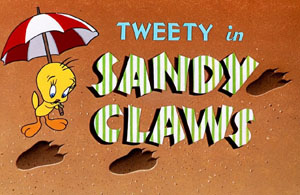 Sandy Claws (Warner, Tweety and Sylvester, 4/2/55 – I. (Friz) Freleng, dir.) – Nominated for an Academy Award. Granny takes Tweety for a day at the beach, setting his cage upon a small rock formation near the shore, while she goes to put on her “new bikini bathing suit”. Inside his cage, Tweety pulls up a miniature chair and beach umbrella, and dons a pair of sunglasses. On a nearby pier, Sylvester attempts to obtain sustinence, forcing a worm at gunpoint to sit on the hook of his rod and reel (a reused gag from Robert McKimson’s “A Fractured Leghorn.”). No sooner does the hook hit the water, than a fish three times Sylvester’s size leaps out of the water and swallows him. Sylvester struggles below the water surface, and barely escapes with his life. “There must be an easier way”, Sylvesters surmises, tossing away his remaining bait. On hearing canary chirps from Tweety’s cage, Sylvester creeps into action so fast, he outraces his paw prints in the sand. He is about to reach into the cage, when he is swamped under by huge waves. The tide has come in, and Tweety’s rock is now only inches above the surface of the water.
Sandy Claws (Warner, Tweety and Sylvester, 4/2/55 – I. (Friz) Freleng, dir.) – Nominated for an Academy Award. Granny takes Tweety for a day at the beach, setting his cage upon a small rock formation near the shore, while she goes to put on her “new bikini bathing suit”. Inside his cage, Tweety pulls up a miniature chair and beach umbrella, and dons a pair of sunglasses. On a nearby pier, Sylvester attempts to obtain sustinence, forcing a worm at gunpoint to sit on the hook of his rod and reel (a reused gag from Robert McKimson’s “A Fractured Leghorn.”). No sooner does the hook hit the water, than a fish three times Sylvester’s size leaps out of the water and swallows him. Sylvester struggles below the water surface, and barely escapes with his life. “There must be an easier way”, Sylvesters surmises, tossing away his remaining bait. On hearing canary chirps from Tweety’s cage, Sylvester creeps into action so fast, he outraces his paw prints in the sand. He is about to reach into the cage, when he is swamped under by huge waves. The tide has come in, and Tweety’s rock is now only inches above the surface of the water.
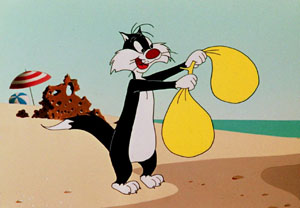 Blackout gags abound as Sylvester explores various ways to reach the water-encircled cage. From a higher cliff, Sulvester detaches the reel from a rod and reel, hooking the rod handle between two boulders. He ties the other end of the fishing line around his waist, and attempts to lower himself to Tweety by uncranking the reel. But the line is not securely fastened to the spool, and merely detaches when fully unwound, letting Sylvester splash into the sea. Sylvester commandeers a motorboat, but forgets to untie it from the dock, ripping off the stern of the ship. He salutes like a sailor as the craft sinks into the briny. Next, he ties an outvoard motor to his back, and approaches on water skis. His aim is directly on target – too good, in fact, as the cat slams face first into Tweety’s rock, while the skis veer off in different directions on either side. The cat reenters the sea with a pair of water wings, but is instantly surrounxded by shark fins. The sharks bite like piranhas, and Syvester returs to the shore with what is left of his fur looking like a loose-fitting single-strap leotard from a jungle picture. Just to complete the effect, Sylvester lets out a pathetically weak Tarzan yell, then faints on the spot.
Blackout gags abound as Sylvester explores various ways to reach the water-encircled cage. From a higher cliff, Sulvester detaches the reel from a rod and reel, hooking the rod handle between two boulders. He ties the other end of the fishing line around his waist, and attempts to lower himself to Tweety by uncranking the reel. But the line is not securely fastened to the spool, and merely detaches when fully unwound, letting Sylvester splash into the sea. Sylvester commandeers a motorboat, but forgets to untie it from the dock, ripping off the stern of the ship. He salutes like a sailor as the craft sinks into the briny. Next, he ties an outvoard motor to his back, and approaches on water skis. His aim is directly on target – too good, in fact, as the cat slams face first into Tweety’s rock, while the skis veer off in different directions on either side. The cat reenters the sea with a pair of water wings, but is instantly surrounxded by shark fins. The sharks bite like piranhas, and Syvester returs to the shore with what is left of his fur looking like a loose-fitting single-strap leotard from a jungle picture. Just to complete the effect, Sylvester lets out a pathetically weak Tarzan yell, then faints on the spot.
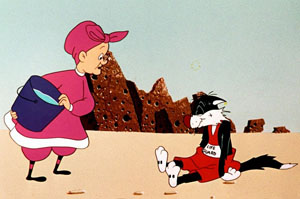 Granny finally returns. Her “bikini” is actually a Victorian suit from the turn of the century. Spotting Tweety stranded on his rock, Granny calls for anyone to help save her bird. Sylvester appears, having nabbed a life guard’s outfit from one of the watch statons. Grabbing a surfboard, he charges bravely toward the ocean – but slams into a pier piling instead. As he sits dazed on the sand, Granny grabs a bucket of water to revive him. She tosses it, just as another huge wive crashes upon the both of them. When the flood waters clear, Sylvester, blaming the whole soggy affair on Granny, chastises her, “Ya didn’t have to overdo it!” Next, Granny attempts to help Sylvester by operating an air pump engine on the pier, while Sylvester descends into the depths with a diving suit. The air supply is okay, until Granny catches sight of Tweety, who has decided that he’ll never be rescued if he waits for that putty tat, so is rowing his cage to shore. Granny descends from the pier to embrace her little bird, forgetting all about the air pump. The pump motor sputters and comes to a stop, while Sylvester, still in the diving suit, frantically waves his paws for more air, turning bright blue in the face. Granny finally reembers the heroic cat, and tries to recall how she got the pump going in the first place. Tugging at a lever, she sets the machine into overdrive. Sylvester’s suit inflates like a ball, and takes to the air. Using a drop seat marked “Escape hatch”, Sylvester pops out of the suit, which vanishes deflating over the horizon, keaving the cat in free fall. Never say Sylvester doesn’t anticipate emergencies, as he pops open a parachute from nowhere, and floats down st a considerable distance from the shore into town. As Granny wonders wat became of the cat, and hopes he receives a just reward, Sylvester gently lands – into the yard of the local dog pound, whee, amidst the unseen sounds of savage growls and carnage, the camera irises out on Sylvester’s “reward”.
Granny finally returns. Her “bikini” is actually a Victorian suit from the turn of the century. Spotting Tweety stranded on his rock, Granny calls for anyone to help save her bird. Sylvester appears, having nabbed a life guard’s outfit from one of the watch statons. Grabbing a surfboard, he charges bravely toward the ocean – but slams into a pier piling instead. As he sits dazed on the sand, Granny grabs a bucket of water to revive him. She tosses it, just as another huge wive crashes upon the both of them. When the flood waters clear, Sylvester, blaming the whole soggy affair on Granny, chastises her, “Ya didn’t have to overdo it!” Next, Granny attempts to help Sylvester by operating an air pump engine on the pier, while Sylvester descends into the depths with a diving suit. The air supply is okay, until Granny catches sight of Tweety, who has decided that he’ll never be rescued if he waits for that putty tat, so is rowing his cage to shore. Granny descends from the pier to embrace her little bird, forgetting all about the air pump. The pump motor sputters and comes to a stop, while Sylvester, still in the diving suit, frantically waves his paws for more air, turning bright blue in the face. Granny finally reembers the heroic cat, and tries to recall how she got the pump going in the first place. Tugging at a lever, she sets the machine into overdrive. Sylvester’s suit inflates like a ball, and takes to the air. Using a drop seat marked “Escape hatch”, Sylvester pops out of the suit, which vanishes deflating over the horizon, keaving the cat in free fall. Never say Sylvester doesn’t anticipate emergencies, as he pops open a parachute from nowhere, and floats down st a considerable distance from the shore into town. As Granny wonders wat became of the cat, and hopes he receives a just reward, Sylvester gently lands – into the yard of the local dog pound, whee, amidst the unseen sounds of savage growls and carnage, the camera irises out on Sylvester’s “reward”.
Here’s an excerpt:
Southbound Duckling (MGM, Tom and Jerry, 3/12/56 – William Hanna/Joseph Barbera, dir,), deserves another honorable mention. Little Quacker gets the notion to follow the passing flocks of wild ducks overhead in Southbound migration – even though Jerry points his attention to a nature book that says domestic ducks do not fly south for the winter. Quacker is not in physical shape to make the flight unaided like his wild cousins, and falls in a heap winded after an extended try to get off the ground. Thus Quacker is forced to resort to artificial means of propulsion, including a slingshot, skyrocket, and a balloon. Throughout his efforts, Tom Cat gets into the act, hoping for an easy duck dinner instead of his watery hobo stew. He takes his usual share of lumps in the process (including swallowing the skyrocket). In the final pursuit, Jerry leads Quacker to the one place he can obtain transportation safely – the airport, where he and Quacker climb aboard a plane bound for Miami. Tom chases them onto the runway, but wids up the pursued instead of the pursuer, as the taxiing plane prepares for takeoff, and bears down upon Tom with its huge wheel.
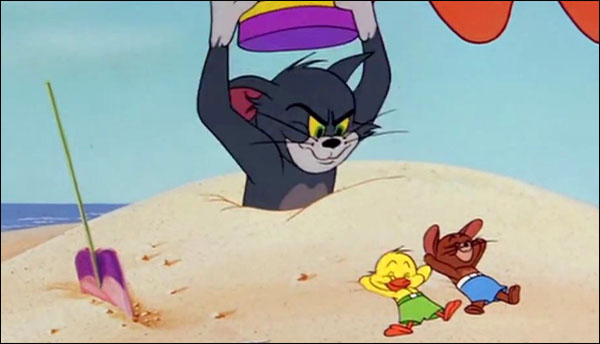
As a dissolve brings us to the arrival of the plane in Miami, we discover that Tom was caught up on the landing gear upon takeoff, and has also made the journey in the wheel well. Now, on the sunny beach, Jerry and Quacker, wearing beach trunks, settle down beneath an umbrella’s shade for an afternoon siesta, as Quacker wonders aloud what became of the old pussy cat. An inverted beach pail in the sand behind them suddenly rises, where Tom lays in wait buried in the sand, wearing the pail atop his head. He slams the pail down over Jerry and Quacker, while Quacker complains about who turned off the lights. In an unusual happy ending for Tom, Tom laughs a deep evil laugh, and, so the audience will be spared the gruesome details of his revenge, pulls down the edge of the beach umbrella to block the camera’s view of the scene, while the words “The End” appear superimposed over the shot.
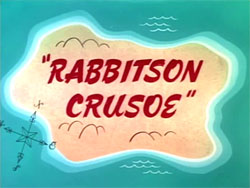 Rabbitson Crusoe (Warner, Bugs Bunny, 4/29/56 – Friz Freleng, dir.), returns is to the legacy of Robinson Crusoe spoofs which has provided a subgenre throughout this series. Yosemite Sam is cast in the role of Robinson, with an opening line of dialog which maks one of the shortest plot expositions in cartoon history. “A low tide and a high rock caused my predicament.” (The brevity of this setup is only challenged in the history of Freleng’s productions by the single panning shot which opens Tweety’s “Bad ol’ Putty Tat”, simply showing a view of Tweety’s bird house on top of a pole, panning down the pole to reveal barbed wire wound around it, and at the foot of the pole a watchful Sylvester, with noticeable patches of his fur already torn off his body by the wire barbs above.) Sam has survived on the island by careful rationing of the ship’s provisions from the wreck amidst the rocks in the lagoon, and through a diet of the island’s only foodstuff – coconuts. Though Sam has come up with as creative an array of presenting the stuff at the dinner table as possible to tempt the palate (including tossed cocoanit salad, fresh cocanut milk, and New England boiled cocoanut), his endurance of the “white meat” is just about as shallow as that of Fox in “Ku Ku Nuts” reviewed earlier in this series – and Sam literally pounds his head into the trunk of a palm tree to numb the thought of eating even another mouthful of the round refugees from a Mounds bar that surround him. To complicate Sam’s life, the island is actually a chain of three small outgrowths from the sea – the rocks where the ship is lodged, Sam’s encampment, and the small island where the sole cocoanut tree grows. Traversing from one location to another involves crossing narrow paths of stepping stones across shllow water inlets – each of which is regularly patrolled by a shark named Dopey Dick. Sam has developed a routine from being 20 years marooned, and has available at the ready a mallet fastened to the cocoanut tree, and a rack of baseball bats on the main island, to clobber the shark with every time he attempts to follow Sam onto the land. But that doesn’t mean the watery crossings aren’t close calls, with the shark nipping at Sam’s toes. Sam has also developed a series of verbal epithets with which to address the shark during his usual ornery moods, sich as “fin flapping flounder” and “no good bushwhacking barracuda.”
Rabbitson Crusoe (Warner, Bugs Bunny, 4/29/56 – Friz Freleng, dir.), returns is to the legacy of Robinson Crusoe spoofs which has provided a subgenre throughout this series. Yosemite Sam is cast in the role of Robinson, with an opening line of dialog which maks one of the shortest plot expositions in cartoon history. “A low tide and a high rock caused my predicament.” (The brevity of this setup is only challenged in the history of Freleng’s productions by the single panning shot which opens Tweety’s “Bad ol’ Putty Tat”, simply showing a view of Tweety’s bird house on top of a pole, panning down the pole to reveal barbed wire wound around it, and at the foot of the pole a watchful Sylvester, with noticeable patches of his fur already torn off his body by the wire barbs above.) Sam has survived on the island by careful rationing of the ship’s provisions from the wreck amidst the rocks in the lagoon, and through a diet of the island’s only foodstuff – coconuts. Though Sam has come up with as creative an array of presenting the stuff at the dinner table as possible to tempt the palate (including tossed cocoanit salad, fresh cocanut milk, and New England boiled cocoanut), his endurance of the “white meat” is just about as shallow as that of Fox in “Ku Ku Nuts” reviewed earlier in this series – and Sam literally pounds his head into the trunk of a palm tree to numb the thought of eating even another mouthful of the round refugees from a Mounds bar that surround him. To complicate Sam’s life, the island is actually a chain of three small outgrowths from the sea – the rocks where the ship is lodged, Sam’s encampment, and the small island where the sole cocoanut tree grows. Traversing from one location to another involves crossing narrow paths of stepping stones across shllow water inlets – each of which is regularly patrolled by a shark named Dopey Dick. Sam has developed a routine from being 20 years marooned, and has available at the ready a mallet fastened to the cocoanut tree, and a rack of baseball bats on the main island, to clobber the shark with every time he attempts to follow Sam onto the land. But that doesn’t mean the watery crossings aren’t close calls, with the shark nipping at Sam’s toes. Sam has also developed a series of verbal epithets with which to address the shark during his usual ornery moods, sich as “fin flapping flounder” and “no good bushwhacking barracuda.”
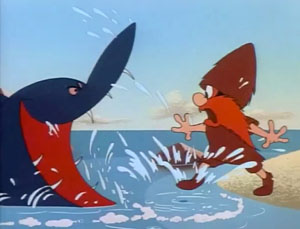 What should appear on the horizon to disturb this scene of domestic non-tranquility but Bugs, a castaway floating in nn open half of a wooden crate. (At least they didn’t nail him in this time, as in “Bugs Bunny Nips the Nips”.) “A rabbit. A stewing rabbit!”, observes Sam, who hails the bunny with a hearty “Ahoy!” Bugs is overjoyed at the sight of land, and begins paddling toward shore, while Sam, taking every precaution not to lose his meal ticket, cautions, “Don’t fall overboard.” A huge wave rises under Bugs’ crate, and Sam ha to run for his life to keep from getting drowned, one step ahead of the curl. Fortunately, he is in just the right place as the wave crashes, to catch Bugs in his arms. He carries the rabbit to the center of the island, where a large cooking pot is the central attraction. “Dry land”, remarks Bugs, “It sure feels good to be dry again.” Bugs doesn’t experience this pleasure for long, as Sam abruptly dumps him in the pot, nearly full of not-yet-heated water. As Bugs attempts to recover from his freshly-dampened spirit, Sam lights a fire below the pot, and announces intention to have rabbit stew. “Where ya gonna get the rabbit?” asks Bugs. “We’ve already got the rabbit. Get the idea”, responds Sam. Bugs gets the idea quickly, coming up with a facial expression that is as twisted as Sam’s plans. But curious Bigs asks how long before dinner is ready. “Just a few minutes, barrig accidents”, says Sam. Reaching into the pot, Bugs produces a ladle, filled with a spoon full of pot water. “Oops. Foist accident!”, he retorts, pouring the fluid to douse Sam’s fire. Sam is furious – especially because matches are scarce, and stored in a secure cabinet in a safe aboard the ship – meaning another encounter with Dopey Dick. Dick almost gets lucky this time upon Sam’s venturing to set his first foot upon the stepping stones, nipping off the toe of Sam’s shoe – and almost getting the toes inside as well. Sam toys with Dick, treating him like a puppy dog, and tricking him into fetching a bone while Sam retrieves the match.
What should appear on the horizon to disturb this scene of domestic non-tranquility but Bugs, a castaway floating in nn open half of a wooden crate. (At least they didn’t nail him in this time, as in “Bugs Bunny Nips the Nips”.) “A rabbit. A stewing rabbit!”, observes Sam, who hails the bunny with a hearty “Ahoy!” Bugs is overjoyed at the sight of land, and begins paddling toward shore, while Sam, taking every precaution not to lose his meal ticket, cautions, “Don’t fall overboard.” A huge wave rises under Bugs’ crate, and Sam ha to run for his life to keep from getting drowned, one step ahead of the curl. Fortunately, he is in just the right place as the wave crashes, to catch Bugs in his arms. He carries the rabbit to the center of the island, where a large cooking pot is the central attraction. “Dry land”, remarks Bugs, “It sure feels good to be dry again.” Bugs doesn’t experience this pleasure for long, as Sam abruptly dumps him in the pot, nearly full of not-yet-heated water. As Bugs attempts to recover from his freshly-dampened spirit, Sam lights a fire below the pot, and announces intention to have rabbit stew. “Where ya gonna get the rabbit?” asks Bugs. “We’ve already got the rabbit. Get the idea”, responds Sam. Bugs gets the idea quickly, coming up with a facial expression that is as twisted as Sam’s plans. But curious Bigs asks how long before dinner is ready. “Just a few minutes, barrig accidents”, says Sam. Reaching into the pot, Bugs produces a ladle, filled with a spoon full of pot water. “Oops. Foist accident!”, he retorts, pouring the fluid to douse Sam’s fire. Sam is furious – especially because matches are scarce, and stored in a secure cabinet in a safe aboard the ship – meaning another encounter with Dopey Dick. Dick almost gets lucky this time upon Sam’s venturing to set his first foot upon the stepping stones, nipping off the toe of Sam’s shoe – and almost getting the toes inside as well. Sam toys with Dick, treating him like a puppy dog, and tricking him into fetching a bone while Sam retrieves the match.
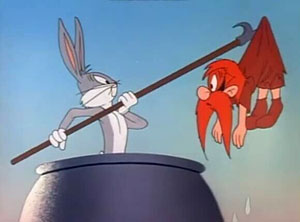 Sam makes it back to the island unopposed, but finds two surprises waiting for him. First, Bigs is no longer in the pot. Second, when Sam looks into the pot water, out pops Dopey Dick, nearly swallowing Sam so that only Sam’s feet are visble. Gaining his footing with Dick atop him, Sam stumbles his way to another mallet hanging on a tree, extendas his arms out of Dick’s mouth to lift it, and bashes at Dick’s head atop him. After a few blows, Dick lets loose – but the dazed Sam keeps right on whacking, now bashing upon his own head. “Yoo hoo. Mr. Robinson” comes a call. (When were they introduced by name?) Bugs is now on the other side of the channel, aboard Sam’s ship. Sam tries for another crossing on a surfboard, but surfs right into Dopey Dock’s open mouth. A little internal head bashing gets Sam free again, but no closer to his rabbit dinner. He tries a second plan, launching himself tied to a balloon. (Does he have a tank somewhere of 20 year old helium?) When the wind is just right, he floats in an arc for a short flight to the ship. Floating down in the downdraft to the ship’s deck. Sam laughs an evil chortle, claiming to have the rabbit at last – until Bugs opens the ship’s main hatch below Sam. Inside the hold, which has been bottomed out in the shipwreck, we see Dopey Dick waiting in a shallow pool below the ship, as Sam’s balloon descends directly into the zone of peril, and Sam’s laugh disintegrates into a pathetic “Hoo hoo.” The snapping of Dopey’s jaws is heard below, and a somewhat tattered Sam appears from one of the ship’s staircases, bashing the shark again with another baseball bat. Bugs is playing “Bunny Hop” again, making his way back to the main island, but Sam catches up with him from behind, and gives him the bum’s rush, straight into the cooking pot. Finally getting to use the new match, Sam relights the fire, then consults his cook book, which instructs to let the rabbit simmer one half hour. Bugs suddenly points over Sam’s shoulder. “Look, it’s a tidal wave!” Possibly suspecting a trick, or just too absorbed in his cooking, Sam responds, “Shut up and start simmerin’!” But the sound of onrushing water causes him to pause, and finally look behind him. Bugs has for one spoken the truth, and a massive wave deluges the island and both characters. After a dissolve, we find Bugs, still inside the cooking pot, but afloat atop the sea.
Sam makes it back to the island unopposed, but finds two surprises waiting for him. First, Bigs is no longer in the pot. Second, when Sam looks into the pot water, out pops Dopey Dick, nearly swallowing Sam so that only Sam’s feet are visble. Gaining his footing with Dick atop him, Sam stumbles his way to another mallet hanging on a tree, extendas his arms out of Dick’s mouth to lift it, and bashes at Dick’s head atop him. After a few blows, Dick lets loose – but the dazed Sam keeps right on whacking, now bashing upon his own head. “Yoo hoo. Mr. Robinson” comes a call. (When were they introduced by name?) Bugs is now on the other side of the channel, aboard Sam’s ship. Sam tries for another crossing on a surfboard, but surfs right into Dopey Dock’s open mouth. A little internal head bashing gets Sam free again, but no closer to his rabbit dinner. He tries a second plan, launching himself tied to a balloon. (Does he have a tank somewhere of 20 year old helium?) When the wind is just right, he floats in an arc for a short flight to the ship. Floating down in the downdraft to the ship’s deck. Sam laughs an evil chortle, claiming to have the rabbit at last – until Bugs opens the ship’s main hatch below Sam. Inside the hold, which has been bottomed out in the shipwreck, we see Dopey Dick waiting in a shallow pool below the ship, as Sam’s balloon descends directly into the zone of peril, and Sam’s laugh disintegrates into a pathetic “Hoo hoo.” The snapping of Dopey’s jaws is heard below, and a somewhat tattered Sam appears from one of the ship’s staircases, bashing the shark again with another baseball bat. Bugs is playing “Bunny Hop” again, making his way back to the main island, but Sam catches up with him from behind, and gives him the bum’s rush, straight into the cooking pot. Finally getting to use the new match, Sam relights the fire, then consults his cook book, which instructs to let the rabbit simmer one half hour. Bugs suddenly points over Sam’s shoulder. “Look, it’s a tidal wave!” Possibly suspecting a trick, or just too absorbed in his cooking, Sam responds, “Shut up and start simmerin’!” But the sound of onrushing water causes him to pause, and finally look behind him. Bugs has for one spoken the truth, and a massive wave deluges the island and both characters. After a dissolve, we find Bugs, still inside the cooking pot, but afloat atop the sea.
“Holy carrot sticks! The island’s gone.” Who should be heard calling for help but Sam, being pursued around the pot by the fin of Dopey Dick. Apparently some flotsam from the ship has washed into the cooking pot from the wave, for Bugs reaches into the pot and produces a harpoon, with which he fishes Sam out of the water. Sam demands Bugs pull him in, but Bugs demands, “Not unless we make a deal.” “No deals!” shouts Sam. “Okat, okay, Back ya go”, responds Bugs, about to deposit Sam back as ready fish bait. “Anything ya say1 It’s a DEAL!”, sputters a panicked Sam. What is the deal? Sam remains suspended on the point of the harpoon, paddling with an oar also apparently swept into the pot from the ship, as propulsion for Bugs’ pot. Dopey Dick remains in pursuit to provide Sam with continued incentive, as the pot floats past a buoy, conveniently placed for any stray castaways to note that San Francisco is only a mere 2,736 miles away.
Muscle Beach Tom (MGM, Tom ad Jerry, 9/7/56 – William Hanna, Joseph Barbera, dir.), has been recently extensively reviewed in this column’s Fitness vs. Fatness series (Part 6) only a short time ago. So the reader is referred there for its discussion. Again, another battle with barbells for the eyes of a hirl, pitting Tom vs. tough-cat Butch, with Jerry along for extra spice. As with Daffy Duck’s “Muscle Tussle”, baloons decide the battle, this time used as inflatable miscles inside Tom’s bathing suit – until Jerry unties the anchor keeping Tom from floating away, and punctures the fake muscles to force Tom into a quick flying exit.
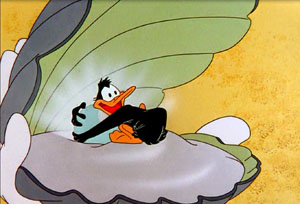 Ali Baba Bunny (Warner, Bugs Bunny, 2/9/57 – Chuck Jones, dir.) – This film really belongs in an article about Arabian Nights cartoons, but must be afforded a very honorable mention here due to the location Bugs is intending to visit in one of his typical burrowing vacations, using high-speed tunneling as his means of transportation. In the middle of the fabled treasure cave of the 40 thieves, out pops Bugs Bunny from the cave floor, believing he has arrived at his destination. “Well here we are! Pismo Beach, and all the clams we can eat!” Blame the mis-navigation upon the usual having failed to take a left turn at Albuquerque (or was it a right turn at La Jolla?) In a surprise touch, for the first time in the series, Daffy Duck is right behind him, complaining at the very idea of a duck having to travel underground. However, while Bugs pauses to get his bearings, Daffy’s greedy little mind has moved completely off the subject of travel – to the hewls and coinage surrounding them in the treasure room. With vengeful selfishness, he stomps forcefully upon his former long-eared pal, driving him back into the rabbit hole, with shouts of “It’s mine, ya understand. All mine. Get back in there. Down, down, down. Go, go, go. MIIINE!!” Of course, Daffy didn’t count on the scimitar-wielding Hassan, guardian of the treasire, to deal with before ownership rights are secured – and it takes a heaping dose of Bugs’s absolute cool to fopl Hassan by means of disguise as a fake genie, together with some of the most hilarious ad-libbing of magic words (“Ickity Ackety Oop”) to make the impression look convincing. With Hassan disposed of, and just as it appears that Daffy has a clear path to his life dream of endless wealth, Daffy finds a stray magic lamp hidden in a last alcove of the treasure cave, with a genie for real. But Daffy thinks he’s another phoney, likely out for the treasure himself, and repeats his stomping act atop the genie’s head. Reappearing in more powerful form, the genie announces that Daffy has desecrated the spitit of the lamp, and must pay the consequences. “Consequences, schmosequences, as long as I’m rich”, shrugs Daffy in utter nonchalance.
Ali Baba Bunny (Warner, Bugs Bunny, 2/9/57 – Chuck Jones, dir.) – This film really belongs in an article about Arabian Nights cartoons, but must be afforded a very honorable mention here due to the location Bugs is intending to visit in one of his typical burrowing vacations, using high-speed tunneling as his means of transportation. In the middle of the fabled treasure cave of the 40 thieves, out pops Bugs Bunny from the cave floor, believing he has arrived at his destination. “Well here we are! Pismo Beach, and all the clams we can eat!” Blame the mis-navigation upon the usual having failed to take a left turn at Albuquerque (or was it a right turn at La Jolla?) In a surprise touch, for the first time in the series, Daffy Duck is right behind him, complaining at the very idea of a duck having to travel underground. However, while Bugs pauses to get his bearings, Daffy’s greedy little mind has moved completely off the subject of travel – to the hewls and coinage surrounding them in the treasure room. With vengeful selfishness, he stomps forcefully upon his former long-eared pal, driving him back into the rabbit hole, with shouts of “It’s mine, ya understand. All mine. Get back in there. Down, down, down. Go, go, go. MIIINE!!” Of course, Daffy didn’t count on the scimitar-wielding Hassan, guardian of the treasire, to deal with before ownership rights are secured – and it takes a heaping dose of Bugs’s absolute cool to fopl Hassan by means of disguise as a fake genie, together with some of the most hilarious ad-libbing of magic words (“Ickity Ackety Oop”) to make the impression look convincing. With Hassan disposed of, and just as it appears that Daffy has a clear path to his life dream of endless wealth, Daffy finds a stray magic lamp hidden in a last alcove of the treasure cave, with a genie for real. But Daffy thinks he’s another phoney, likely out for the treasure himself, and repeats his stomping act atop the genie’s head. Reappearing in more powerful form, the genie announces that Daffy has desecrated the spitit of the lamp, and must pay the consequences. “Consequences, schmosequences, as long as I’m rich”, shrugs Daffy in utter nonchalance.
Bugs figures now’s the time for getting while the getting’s good, and leaves the duck to his fate, diving back into the rabbit hole and retracing his steps to return to the good old U.S.A. Meanwhile, electrical rays from the genie’s fingertips envelop Daffy, holding him in frozen helplessness as he bounces around violently in the rays’ force field. The scene dissolves, and for the first time in the series’ history, Bugs is seen having finally reached his original intended destination – sitting on a beach blanket under an umbrella labeled “Pismo Beach”. A shovel rests in the sand nearby, next to which is a hefty pile of clamshells Bugs has dug up. “I wonder how that crazy duck ever made out with that genie?”, Bugs soliloquizes to himself while prying open a clamshell. To his surprise, inside he finds a pearl. No sooner is the bauble revealed, then out of the rabbit hole beside Bugs on the beach pops Daffy – reduced to the size of a mouse, and talking in a miniature, sped-up chipmunk-style voice “It’s mine, ya understand. Go, go, go”, he repeats, racing up Bugs’s arm and into the shell, to seize and cling to the pearl possessively. “Oh brother. Close, sesame”, says a disgusted Bugs to the clamshell. In the manner of the stone door of the treasure cave, the clamshell slowly closes upon Daffy, who, ignoring entirely the shell’s closing, prepares to presumably reside in splendor with his new found wealth forevermore inside the shell, with the curtain line, “I’m rich. I’m a happy miser.”
 Which is Witch (Paramount/Famous, Casper, 5/2/58 – Seymour Kneitel, dir.) – Not a personal favorite from this series. Whether in search of new storyline ideas, or under commercial pressure from the executive office to begin to cross-pollinate ideas tying in with the lucrative comics franchise of Harvey Comics, several characters originating or popularized from the magazines such as “Casper’s Ghostland” were beginning to show up on the animated front. The Ghostly Trio had made their debut a few seasons prior in “Fright From Wrong”. Spooky, who might possibly have been a creation of the animation studio, but who was introduced in very different appearance than the comics model, including no “doiby” hat, is featured in this film transformed into his classic comics self. Most notably, however, this film marks the only theatrical appearance of Harvey’s creation, Wendy, the Good Little Witch. Despite being a new face on the screen, the studio does practically nothing to provide background or set-up for the character’s appearance in the series, but takes it for absolute granted that everyone has been following the comics, and already knows who she is. To make things even more odd, she only appears in her trademark red robes for the first few of her shots, then abandons her outfit altogether to be replaced with a two-piece bathing suit for a day on the sand. The transformation makes her virtually unrecognizable as the comics character throughout most of the episode – and she never once makes use of her wand or broom – making for possibly the weakest introduction in animation history of an alleged series character. It is no wonder (although perhaps the true cause was the sheer lack of time to generate another script due to the Harvey contract that took all rights to the characters away from Paramount a short time later) that there were no repeat appearances for the witch girl on the big screen. Later, when Paramount was contracted by Harvey to produce a series of episodes for the “New Casper Cartoon Show”, someone got it right and stuck to the comics model, providing a recognizable image for the character and some opportunity for her to perform her feats of magic – finally providing her with some life beyond the printed page, which would carry her legacy on to subsequent generations.
Which is Witch (Paramount/Famous, Casper, 5/2/58 – Seymour Kneitel, dir.) – Not a personal favorite from this series. Whether in search of new storyline ideas, or under commercial pressure from the executive office to begin to cross-pollinate ideas tying in with the lucrative comics franchise of Harvey Comics, several characters originating or popularized from the magazines such as “Casper’s Ghostland” were beginning to show up on the animated front. The Ghostly Trio had made their debut a few seasons prior in “Fright From Wrong”. Spooky, who might possibly have been a creation of the animation studio, but who was introduced in very different appearance than the comics model, including no “doiby” hat, is featured in this film transformed into his classic comics self. Most notably, however, this film marks the only theatrical appearance of Harvey’s creation, Wendy, the Good Little Witch. Despite being a new face on the screen, the studio does practically nothing to provide background or set-up for the character’s appearance in the series, but takes it for absolute granted that everyone has been following the comics, and already knows who she is. To make things even more odd, she only appears in her trademark red robes for the first few of her shots, then abandons her outfit altogether to be replaced with a two-piece bathing suit for a day on the sand. The transformation makes her virtually unrecognizable as the comics character throughout most of the episode – and she never once makes use of her wand or broom – making for possibly the weakest introduction in animation history of an alleged series character. It is no wonder (although perhaps the true cause was the sheer lack of time to generate another script due to the Harvey contract that took all rights to the characters away from Paramount a short time later) that there were no repeat appearances for the witch girl on the big screen. Later, when Paramount was contracted by Harvey to produce a series of episodes for the “New Casper Cartoon Show”, someone got it right and stuck to the comics model, providing a recognizable image for the character and some opportunity for her to perform her feats of magic – finally providing her with some life beyond the printed page, which would carry her legacy on to subsequent generations.
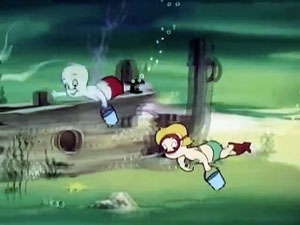 Spooky (invisible along with Casper) is playing a little catch between them with a baseball, en route to the local sandlot. Casper is in an odd, forgetful mood today, as, after going to all the trouble of accompanying Spooky to the playing field, he “balks” at going inside, suddenly remembering he has a date with Wendy. Spooky grumbles at being left in the lurch, and calls all girls “joy killers”, angrily tossing the ball against the ground, only to get bonked with it on the rebound. The scene changes to Wendy’s home. The animators again don’t follow the comics model to even get her living situation right, with no sign of her three hag aunties. Instead, Wendy is sharing living quarters with another child-witch named (what else) Hazel, who at least gets to demonstrate some magic by flying off on her own broom (complete with stick shift). Casper arrives, and carries all the beach gear for the day while Wendy switches into bathing suit. Spooky vows to “crab” the romance, first by slipping a live crab into the beach umbrella, to drop in front of Wendy for a surprise. Wendy rolls out a picnic blanket, and places a layer cake in its center. Spooky dives into the sand, coming up under the blanket to flip the cake onto Wendy’s head, then drops the blanket over Casper so that he’ll appear to have been the practical joker. Casper tries to make amends by helping Wendy dive for shells to add to her collection. Spooky consumes a bottle of ink to blacken himself, then dives into the water, assuming the shape of an octopus. After frightening Wendy, he spits out the ink upon Casper, leaving him to again be blamed for the joke in view of his darkened appearance. Wendy gives Casper a final ultimatum of no more tricks, or she’ll go home. Spooky spoils a powerboat ride by misdirecting the rudder from underwater, causing the boat to crash. Wendy leaves in a huff, but Casper finds Spooky still hanging on to the motor, and Spooky confesses his motive to get Casper back to the ball game. Casper follows Wendy home, and tries to explain it was Spooky all the time – until Spooky makes clear that Casper is right by hollering for Casper to come out and play ball. Instead, Witch Hazel pinch hits, and shows the smarty up with tricks from her broom, that allow her to slide home for the winning run, leaving Spooky to renew his classification of girls as “joy killers”. A dull and lifeless storyline that develops no real laughs, seeming to be aimed only at the little ones with nothing to offer the adults. Indeed, “Grown ups don’t understand why children love him the most.”
Spooky (invisible along with Casper) is playing a little catch between them with a baseball, en route to the local sandlot. Casper is in an odd, forgetful mood today, as, after going to all the trouble of accompanying Spooky to the playing field, he “balks” at going inside, suddenly remembering he has a date with Wendy. Spooky grumbles at being left in the lurch, and calls all girls “joy killers”, angrily tossing the ball against the ground, only to get bonked with it on the rebound. The scene changes to Wendy’s home. The animators again don’t follow the comics model to even get her living situation right, with no sign of her three hag aunties. Instead, Wendy is sharing living quarters with another child-witch named (what else) Hazel, who at least gets to demonstrate some magic by flying off on her own broom (complete with stick shift). Casper arrives, and carries all the beach gear for the day while Wendy switches into bathing suit. Spooky vows to “crab” the romance, first by slipping a live crab into the beach umbrella, to drop in front of Wendy for a surprise. Wendy rolls out a picnic blanket, and places a layer cake in its center. Spooky dives into the sand, coming up under the blanket to flip the cake onto Wendy’s head, then drops the blanket over Casper so that he’ll appear to have been the practical joker. Casper tries to make amends by helping Wendy dive for shells to add to her collection. Spooky consumes a bottle of ink to blacken himself, then dives into the water, assuming the shape of an octopus. After frightening Wendy, he spits out the ink upon Casper, leaving him to again be blamed for the joke in view of his darkened appearance. Wendy gives Casper a final ultimatum of no more tricks, or she’ll go home. Spooky spoils a powerboat ride by misdirecting the rudder from underwater, causing the boat to crash. Wendy leaves in a huff, but Casper finds Spooky still hanging on to the motor, and Spooky confesses his motive to get Casper back to the ball game. Casper follows Wendy home, and tries to explain it was Spooky all the time – until Spooky makes clear that Casper is right by hollering for Casper to come out and play ball. Instead, Witch Hazel pinch hits, and shows the smarty up with tricks from her broom, that allow her to slide home for the winning run, leaving Spooky to renew his classification of girls as “joy killers”. A dull and lifeless storyline that develops no real laughs, seeming to be aimed only at the little ones with nothing to offer the adults. Indeed, “Grown ups don’t understand why children love him the most.”
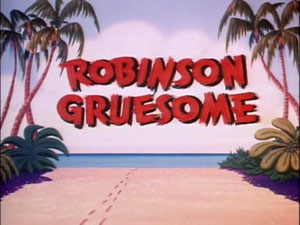 Robinson Gruesome (Lantz/Universal, Chilly Willy, 2/2/59 – Alex Lovy, dir.) – Chilly Willy on a sandy beach? Another studio had provided precedent, in the segment of Disney’s “The Three Caballeros” entitled, “The Cold-Blooded Penguin”, in which another penguin, similarly disdainful of the antarctic weather, sails to the Galapagos islamds, and in the final shot reaches his goal, basking in a hammock in a new coat of tan. Chilly, however, is not a nabigator like his previous feathered counterpart. His voyage begins when he is trapped upon an iceberg broken off from a South Pole glacier. As the floe heads north, it rapidly disintegrates in size, until its last stepping stone of space descends beneath the waves, taking Chilly along, who (although penguins are well known to be terrific swimmers), waves a bye bye to the camera as if about to go down for the third time. Instead, he finds himself standing only waist deep in shallow water – as the iceberg has reached the bay of the isle of Robinson Gruesome (a sign outside his hut advertises “28 years in same location”). Today, the role of Robinson falls upon the shoulders of Chilly’s regular dog adversary, Smedly, who, in similar manner to Fox and Yosemite Sam, faces a table full of the island’s only foodstuff – bananas. One swallow gives him a case of hiccups and indigestion, and een his tonhue is coated a banana yellow. Smedly is shocked to hear a knock at the door, and, upon first seeing Chilly in his doorway, thinks its just a hallucination. But a secind look provides a clearer view of prospects for the future, as Smedly visualizes Chilly as a walking roast chicken. “I’m pleased to eat you – I mean, meet you”, says an eager Smedly. “You’re just in time for dinner.” He layers a frying pan with dough, tucking Chilly in as if preparing him a comfy bed and blanket. But before Smedly can insert the pan into the oven for a “penguin pizza pie”, Chilly substitutes a stick of dynamite for the dough’s contents. The oven is lit, and the dough begins to toast, sending aroma trails wafting into the jungle. A gorilla is awakened by the smell (particularly as the aroma trail forms into the shape of a hand, and whacks the ape across the face). Withot a moment’s pause, the Gorills bashes a hole through the wall of the hut, shoves Smedly aside, and rips the oven door off to see what’s inside – just in time for the explosion. The gorilla’s head emerges from the oven – largely uninjured, except that the irises of both of his eyes are shoved over onto one eyeball, causing the gorilla to whack himself in the head with one hand to knock the out-of-place iris back to normal position. He takes his frustration out on Smedly, by picking the dog up by the nose, and socking him into the wall of the hut.
Robinson Gruesome (Lantz/Universal, Chilly Willy, 2/2/59 – Alex Lovy, dir.) – Chilly Willy on a sandy beach? Another studio had provided precedent, in the segment of Disney’s “The Three Caballeros” entitled, “The Cold-Blooded Penguin”, in which another penguin, similarly disdainful of the antarctic weather, sails to the Galapagos islamds, and in the final shot reaches his goal, basking in a hammock in a new coat of tan. Chilly, however, is not a nabigator like his previous feathered counterpart. His voyage begins when he is trapped upon an iceberg broken off from a South Pole glacier. As the floe heads north, it rapidly disintegrates in size, until its last stepping stone of space descends beneath the waves, taking Chilly along, who (although penguins are well known to be terrific swimmers), waves a bye bye to the camera as if about to go down for the third time. Instead, he finds himself standing only waist deep in shallow water – as the iceberg has reached the bay of the isle of Robinson Gruesome (a sign outside his hut advertises “28 years in same location”). Today, the role of Robinson falls upon the shoulders of Chilly’s regular dog adversary, Smedly, who, in similar manner to Fox and Yosemite Sam, faces a table full of the island’s only foodstuff – bananas. One swallow gives him a case of hiccups and indigestion, and een his tonhue is coated a banana yellow. Smedly is shocked to hear a knock at the door, and, upon first seeing Chilly in his doorway, thinks its just a hallucination. But a secind look provides a clearer view of prospects for the future, as Smedly visualizes Chilly as a walking roast chicken. “I’m pleased to eat you – I mean, meet you”, says an eager Smedly. “You’re just in time for dinner.” He layers a frying pan with dough, tucking Chilly in as if preparing him a comfy bed and blanket. But before Smedly can insert the pan into the oven for a “penguin pizza pie”, Chilly substitutes a stick of dynamite for the dough’s contents. The oven is lit, and the dough begins to toast, sending aroma trails wafting into the jungle. A gorilla is awakened by the smell (particularly as the aroma trail forms into the shape of a hand, and whacks the ape across the face). Withot a moment’s pause, the Gorills bashes a hole through the wall of the hut, shoves Smedly aside, and rips the oven door off to see what’s inside – just in time for the explosion. The gorilla’s head emerges from the oven – largely uninjured, except that the irises of both of his eyes are shoved over onto one eyeball, causing the gorilla to whack himself in the head with one hand to knock the out-of-place iris back to normal position. He takes his frustration out on Smedly, by picking the dog up by the nose, and socking him into the wall of the hut.
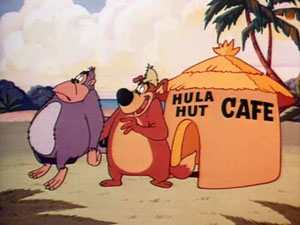 Smedly resorts to various means to catch Chilly. A fake “Hula Hula Hut” advertising free lunches is a concealment for a pit trap dug by Smedly. While Chilly is the only one seen entering, the contents of he pit wind up being the gorilla instead, who socks Smedly again, this time through a tree trunk. “That boy don’t know his own strength”, remarks a battered Smedly. Smedly next retrieves his old blunderbuss, and attempts to fire at the penguin, but the gun jams. Helpful Chilly takes hold of the weapon, and easily fires off three shors – all of which land in the rear end of the gorilla. Chilly hands the gun back to Smedly just in time for the ape to think Smedly fired the shots – and Smedley pays by being stretched into the dimensions of a long dachshund. Next, while pursuing Chilly with a club, Smedley screeches to a stop, facing the barrel of an old cannon Chilly has found from nowhere, with Chilly atop the weapon, ready to light the fuse. Smedley raises a white flag, and states, “I’m under a flag of truce, boy, and you know what that means.” A blast from the cannon hits him in the face anyway, and Smedley notes to the audience, “I guess he doesn’t”, as his tattered banner descends to half mast. Smedly finally tries a boomerang, expecting the weapon to reteve the penguin and return. Instead, it returns bearing the gorilla. Not waiting for the ape’s revenge again, Smedly announces, “Man. I’m a-gettin’ off this island.” He races to a tree with an aze, chops it down, and with lightning speed fashions it into a canoe and oar. He takes to the water, happy that at last he has gotten rid of that big ape. But a line extends from the rear of the canoe, to which is attached a water skier’s handle. The gorilla rides in tow, atop a surfboard, telling the audience, “That’s what he thinks.” Finally, to the rear of the gorilla’s surfboard is attached another tow line, pulling Chilly on another surfboard, who is leaving the island, too, and waves goodbye to the audience for the fade out.
Smedly resorts to various means to catch Chilly. A fake “Hula Hula Hut” advertising free lunches is a concealment for a pit trap dug by Smedly. While Chilly is the only one seen entering, the contents of he pit wind up being the gorilla instead, who socks Smedly again, this time through a tree trunk. “That boy don’t know his own strength”, remarks a battered Smedly. Smedly next retrieves his old blunderbuss, and attempts to fire at the penguin, but the gun jams. Helpful Chilly takes hold of the weapon, and easily fires off three shors – all of which land in the rear end of the gorilla. Chilly hands the gun back to Smedly just in time for the ape to think Smedly fired the shots – and Smedley pays by being stretched into the dimensions of a long dachshund. Next, while pursuing Chilly with a club, Smedley screeches to a stop, facing the barrel of an old cannon Chilly has found from nowhere, with Chilly atop the weapon, ready to light the fuse. Smedley raises a white flag, and states, “I’m under a flag of truce, boy, and you know what that means.” A blast from the cannon hits him in the face anyway, and Smedley notes to the audience, “I guess he doesn’t”, as his tattered banner descends to half mast. Smedly finally tries a boomerang, expecting the weapon to reteve the penguin and return. Instead, it returns bearing the gorilla. Not waiting for the ape’s revenge again, Smedly announces, “Man. I’m a-gettin’ off this island.” He races to a tree with an aze, chops it down, and with lightning speed fashions it into a canoe and oar. He takes to the water, happy that at last he has gotten rid of that big ape. But a line extends from the rear of the canoe, to which is attached a water skier’s handle. The gorilla rides in tow, atop a surfboard, telling the audience, “That’s what he thinks.” Finally, to the rear of the gorilla’s surfboard is attached another tow line, pulling Chilly on another surfboard, who is leaving the island, too, and waves goodbye to the audience for the fade out.
The 60’s are upon us next week.
